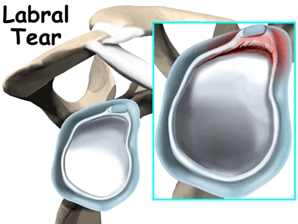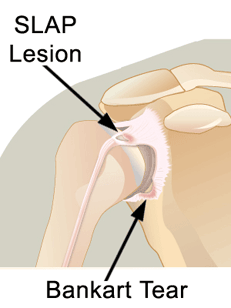Labral Tears
The shoulder joint is similar to the hip as they are both ball and socket joints. However, the shoulder joint’s socket is more shallow, which makes it inherently less stable. This means that extra support is needed to adequately hold the shoulder bones in place.

To compensate for this shallow socket, the shoulder has a cuff of cartilage known as the labrum surrounding its joint. The labrum forms a cup for the end of the arm bone (the humerus) to move around in. The labrum circles the shallow shoulder socket (the glenoid) to make the socket deeper. This cuff of cartilage allows the shoulder to have a wide range of movements, while at the same time improving stability.
What is a labral tear?
The labrum is a thick tissue and can be injured by trauma to the shoulder joint. As a person ages, the labrum becomes more brittle and the aging process can cause fraying or tears. When the labrum becomes torn or frayed, it can cause pain with movements and a loss of stability in the shoulder.
Labral Tear Symptoms
Labral tear symptoms depend on the location of the tear, but can include:
- Pain with specific activities
- An aching sensation in the shoulder joint
- A “catching” sensation of the shoulder with movement
- Some types of labral tears can increase the potential for shoulder dislocations, such as a Bankart lesion.
Common Types of Labral Tears
SLAP Tears - A SLAP tear is most commonly seen in athletes that play overhead throwing sports, such as baseball or tennis. In a SLAP tear, the labrum tears at the top of the shoulder socket where the bicep tendon attaches to the shoulder.
Bankart Lesions - A Bankart lesion occurs when a shoulder dislocates. The labrum is torn when the shoulder out of the joint, and makes the shoulder more susceptible to future dislocations.

Labral Tear Treatment
There are different treatments for different types of labral tears, depending on the type of tear that has occurred. Most types of labral tears don’t require any type of surgery, although patients who have persistent symptoms or more complex tears may need surgery.






